Yuneec Typhoon 4K

Written by Terry Dunn Aerial platform combines quality and simplicity Product review Photos by the author
Bonus video
Specifications
Model type: Prebuilt aerial photography multirotor Skill level: Intermediate to experienced Frame diameter: 500mm Radio: Ten-channel ST10+ 2.4 GHz system with integrated 5.5-inch touchscreen and 5.8 GHz video downlink Minimum flying area: Large park Flying weight: 64.3 ounces Needed to complete: Nothing Power system: Four outrunner brushless motors with 13-inch propellers, two 3S 5,400 mAh LiPo batteries (included) Flight duration: 15 to 20 minutes Price: $799.99 (package with airframe, transmitter, two batteries, charger, SteadyGrip handheld mount, and an aluminum carrying case)Pluses
• Excellent transmitter with integrated video feed. • Gentle flight characteristics. • Ultra high-definition (HD) 4K camera.Minuses
• Gimbal sometimes drifts in roll axis. • Sunshade does not stay in place well.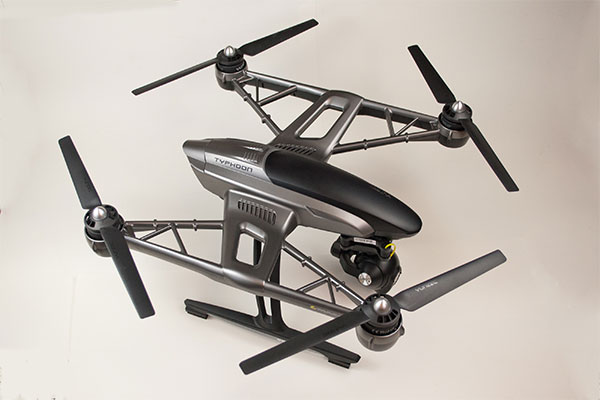
The Typhoon 4K is factory assembled. Although its larger size improves visibility, the dark color scheme does not.
Product review
Anyone in the market for an aerial photography (AP) multirotor will quickly realize that there is an overwhelming selection of models from which to choose. There is also a significant overlap in capabilities and features among the competing brands. It is important to uncover the unique attributes of each model and decide what matters to you. You sometimes have to dig to find the particular features and capabilities that set one AP multirotor apart. That is not the case with the Yuneec Typhoon 4K. Some of its distinctive features are obvious. With a 500mm frame diameter, this quadcopter is significantly larger than most other consumer AP aircraft, making it easier to see in flight. Another noteworthy feature is its ST10+ radio system. This transmitter is slightly larger than most, but that’s because it has a built-in 5.5-inch touchscreen for viewing the real-time video downlink. Although most AP platforms require you to run an app on a tablet or smartphone to view video from the multirotor, it’s an integrated feature of the 4K and ST10+. Thinking back on the myriad problems I’ve experienced with other AP multirotors because of buggy apps and unreliable connections, I appreciate the simplicity that the Yuneec system offers.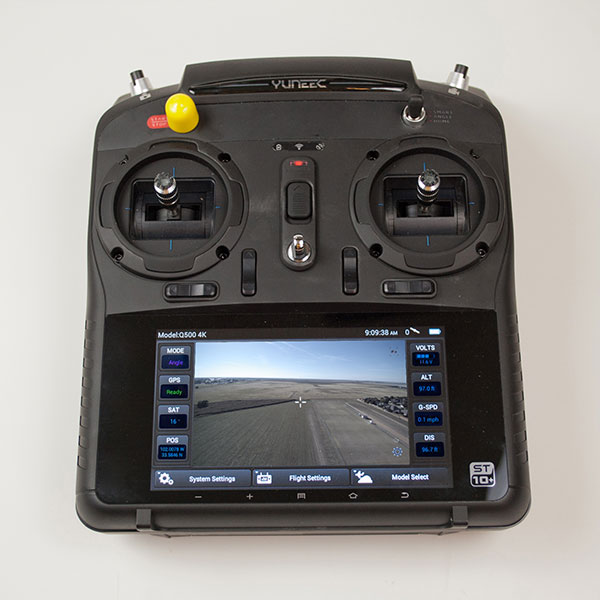
An integrated video screen on the ST10+ transmitter allows you to watch the video feed without using any external components.
Overview
The Typhoon 4K airframe is made from molded plastic. Overall mold quality, fit, and finish of the parts is good, but I wish that the colors were brighter and offered more visual contrast. In-flight orientation of multirotors is inherently difficult. Although the Typhoon’s larger size helps with visual tracking, its black and dark gray hues do not. Brushless motors on each corner spin 13-inch diameter propellers. The propellers thread onto the motor shafts and a simple tool is provided for tightening. All of the electronics are internally housed. Power is provided by a proprietary 3S 5,400 mAh LiPo battery and a spring-loaded hatch provides access to the battery bay. Physically installing the battery completes the electrical connections.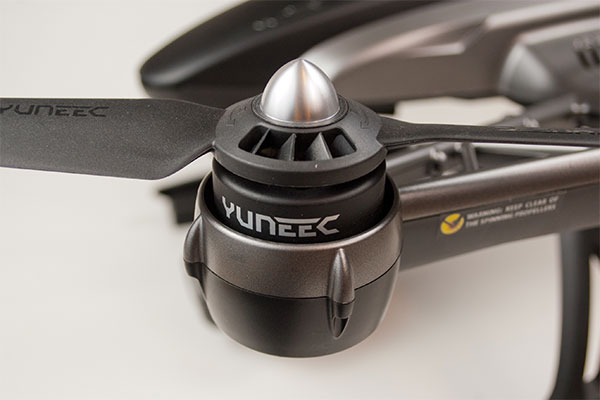
The 13-inch diameter propellers thread onto the hubs of the Typhoon’s brushless motors.
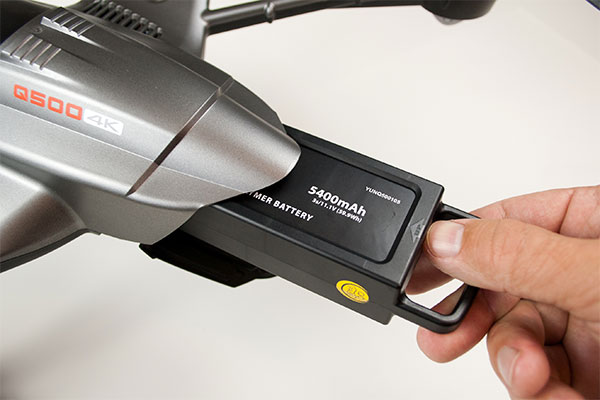
A proprietary 3S 5,400 mAh battery provides flight times of 15 to 20 minutes.
The soul of any AP multirotor is its camera. The CGO3 unit included with the Typhoon 4K combines a camera with a three-axis gimbal. This rig is capable of shooting 12-megapixel still photos and 4K video (3840 x 2160 pixels at 30 frames per second). You can also choose a variety of lower-resolution settings and different frame rates. The photo and video files are recorded to an onboard micro SD memory card. The modular CGO3 simply clips into place on the belly of the Typhoon, allowing you to remove the camera for non-AP flights. The package that I reviewed also includes a SteadyGrip handheld mount for the CGO3. This device allows you to capture smooth ground-based footage with the camera. When using the SteadyGrip, you control the camera via the CGO3 app on your smartphone. In addition to the SteadyGrip, this package includes a spare battery. Everything comes housed in a nice aluminum case. If you’ve never utilized a hard case or backpack for an AP multirotor, you’ll be amazed how convenient it is to be able to store and transport everything you need in one easy-to-carry bundle. The case also protects the equipment from hangar rash.
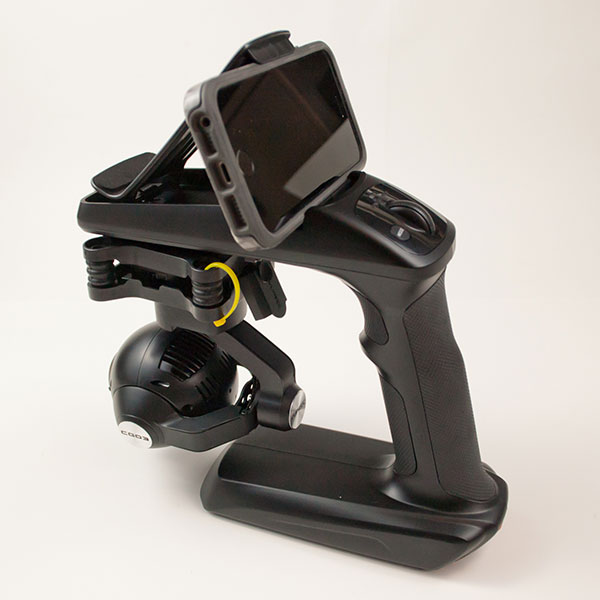
The SteadyGrip is a handheld mount for the CGO3 camera/gimbal that lets you shoot ground-based footage.
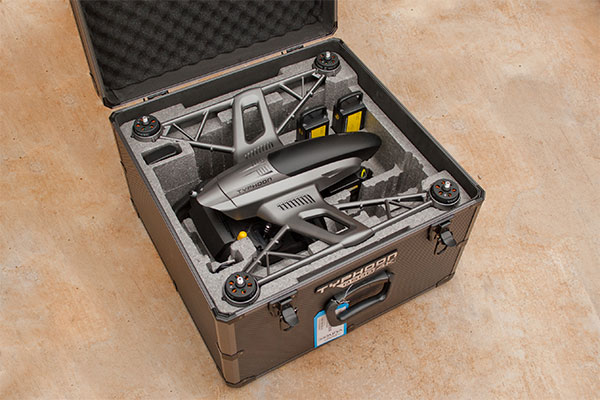
The Typhoon 4K package that the author reviewed includes an aluminum case that offers convenient storage and transport.
There are no required assembly tasks to prepare the Typhoon 4K for flight. Before getting airborne, I recommend that you review the complete user manual and familiarize yourself with the model’s features and controls. There are many functions and controls to be aware of that could mean the difference between having a great maiden flight or a crash. The micro SD card included with my kit had preloaded tutorial videos and literature, but the user manual was an older version. Make sure you get the latest updates from the Yuneec website.
Helpful Hints
The ST10+ transmitter uses three push buttons to start the motors, take a photo, and start/stop video recording. The motor and photo buttons are relatively close to each other. I know of at least one pilot, who intended to shoot a photo, but accidentally pushed the wrong button and shut down his motors in flight. It didn’t end well. To mitigate that possibility, I covered the motor button with a 3/8-inch rubber thread protector. This common hardware store item fits snugly over the base of the button. It is still possible to engage the button with the protector in place, but I am less likely to confuse it with the camera button.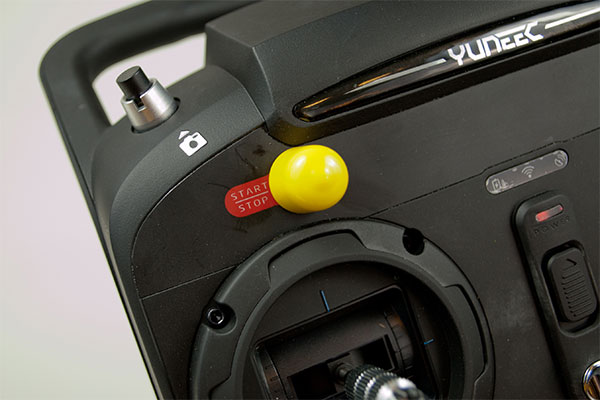
The author installed this rubber thread protector over the motor’s start/stop switch to prevent an unintentional motor shutdown in flight.
The CGO3 is suspended by four rubber isolation mounts. It is possible for these isolators to pull free from their anchor points during minor crashes or even rough landings. If this happens, you’ll probably rip the camera’s wires off of the control board. I suggest that you loop a zip tie through at least two of the isolators. The zip ties should be slightly loose when the camera is hanging. This will preserve your wires in all but the worst of crashes.
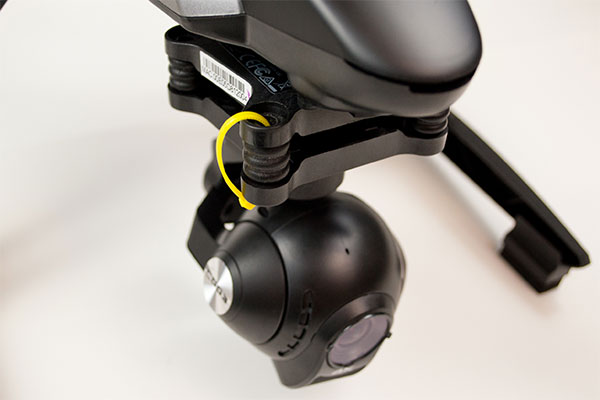
Adding zip ties around the CGO3’s rubber mounts will prevent the unit from breaking free in a crash and causing further damage.
Flying the Typhoon 4K
Thanks to the integrated video system, field preparation for the Typhoon is easy. After installing the propellers and battery, turn on the ST10+, power up the multirotor, and wait for it to arm. Lights on the airframe and indicators on the transmitter will tell you when everything is ready to go. You can choose between two basic flight modes: Smart Mode or Angle Mode. Smart Mode interprets the command inputs from your ground-based frame of reference. For instance, pushing the right stick forward will always make the Typhoon move directly away from you … no matter which way the nose of the multirotor is pointing. Moving the right stick to the left will send it in a counterclockwise orbit around you. The control inputs in Angle Mode are relative to the aircraft. This is the frame of reference that we’re used to in traditional model aircraft. Pushing forward on the right stick will command the Typhoon to move in whichever direction the nose is currently facing. Left input on the same control stick makes the multirotor slide to its left.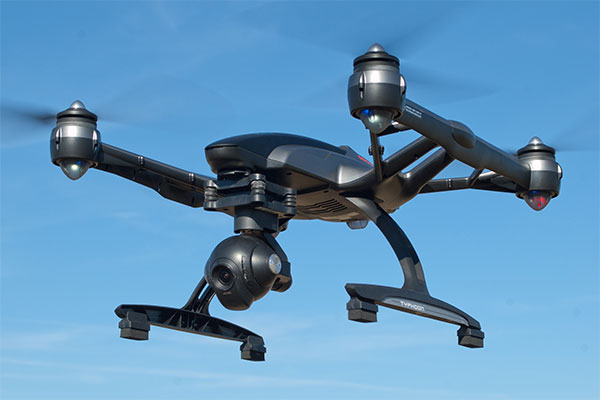
The Typhoon 4K behaves well in flight. Its gentle flying traits are ideal for shooting video.
A three-position switch is used to select the desired flight mode. The third position is for Home Mode. Choosing this option commands the Typhoon 4K to automatically return and land at its original takeoff location. Some people use Home Mode as a default landing process. I prefer to save it for emergencies. Smart Mode might be more intuitive to beginning pilots because they don’t have to worry about the multirotor’s orientation as they fly. There is, however, an element of risk involved with Smart Mode since it is dependent on GPS reception. If you somehow lose your GPS link during flight, you also lose Smart Mode and Home Mode. You should invest time into becoming competent with Angle Mode so that you’re prepared. Most of us are familiar with using dual-rate switches to change a model’s control sensitivity in flight. The Typhoon 4K uses a slider to allow infinite adjustment of its control response. This single slider on the right side of the ST10+ simultaneously affects pitch, roll, and yaw sensitivities. Tortoise and hare icons at each end of the slider cleverly indicate its functionality. Unfortunately, there isn’t a method to fine-tune the control response of an individual axis. I found the Typhoon 4K to be extremely easy to fly. This is especially true on the “tortoise” end of the control settings. The quadcopter is docile and predictable—exactly how you want an AP multirotor to behave. Even at “full hare” control, the Typhoon remains easy to manage. It offers good range of performance for AP tasks, but it falls short of what I would call sporty.
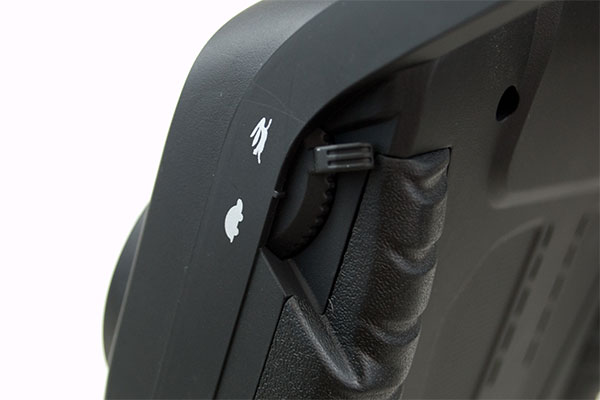
A slider on the ST10+ allows precise adjustment of the Typhoon’s control response.
In all settings, the yaw response is considerably slower than pitch or roll. Overcoming this is a matter of getting used to making large yaw commands along with modest pitch and roll inputs. I don’t even notice the difference now that I’ve adjusted my flying style throughout the course of numerous flights. Smart Mode offers two ancillary functions called Follow Me and Watch Me. In both cases, the Typhoon 4K will maintain a set distance and orientation with the pilot if he or she moves around while flying. You can basically walk across your flying field and the multirotor will automatically keep pace with you. Watch Me keeps the camera trained on the pilot, while Follow Me allows you to point the camera in any direction. Yuneec claims 25-minute flight times are possible, but I get 15 to 20 minutes from each battery. More aggressive flying results in shorter flights. Having a spare battery is definitely a plus. The included charger can handle one battery at a time and each takes approximately two hours to charge.
Shooting Photos and Video
The CG03’s three-axis gimbal works well to isolate the Typhoon’s movements from the video footage. The left side of the transmitter has a slider that allows you to control the pitch angle of the camera. It can be set anywhere within a range of travel of approximately 90°. Overall, the video quality is good. There are a few color settings that will affect the appearance of your photos and video. The Raw option produces flat colors without much contrast, but it’s a good starting point for those who like to do their own color editing. The other options produce vibrant results that you might prefer.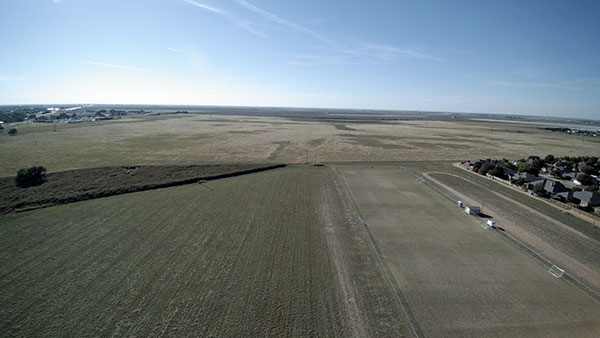
The CGO3 camera/gimbal shoots video at 4K resolution and 12-megapixel still photos.
My only significant complaint about the CGO3—and really the entire Typhoon 4K package—is that the gimbal sometimes drifts in the roll axis. When this happens, the camera leans at a strange angle rather than remaining level with the horizon. It generally clears up on its own after a few seconds, yet I experienced one instance where I had to land and reboot the Typhoon to get things back on track. There is a noticeable delay in the video downlink. This latency seems to increase as the Typhoon 4K gets farther away from the pilot. The delay is approximately one to two seconds. This is completely manageable given the moderate speed of this multirotor. Keep in mind that the video feed is only meant to provide a reference for framing your shots. Avoid the temptation to use the video screen for FPV flying. It might be too late to avoid an obstacle by the time you see it on your screen! You could have trouble seeing the ST10+ screen in direct sunlight. The kit includes a foldout sunshade that attaches with suction cups, but I found that the suction cups don’t hold well. Additionally, the shade can also rock on its mounts and impede access to the touchscreen. Making do without the shade has not presented any difficulties.










1 comments
st 10 transmitter
Add new comment